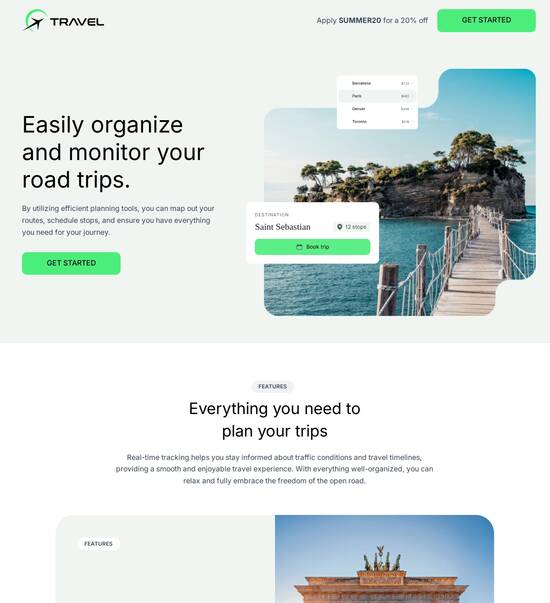
Blog page template for cement companies
Explore Similar TemplatesAbout template
Reach out to the right audience with blog page template for cement companies
Recommended templates

Easy to build without coding
With the intuitive drag-and-drop builder, anyone on your team can create high-converting pages without any knowledge of code or design. Make enhancements to your landing page with custom widgets using Javascript, HTML/CSS, or third-party scripts.

Multiple layouts for any industry and goal
Select from 500+ landing page layouts built to boost conversions across industry-specific scenarios. Customize them by adjusting fonts, adding images, and generating on-brand content with the AI assistant. Quickly scale with Instablocks® and Global Blocks that you can save, reuse, and update globally.

Loads fast and looks polished on any device
Every template is responsive, which means they present professionally on any device and load blazingly fast with our Thor Render Engine. You can also power them up with Google AMP technology to deliver an unparalleled mobile experience and drive higher conversions.

Robust analytics & experimentation
Get real-time updates and reporting across all your devices, showing the number of visitors, conversions, cost-per-visitor, and cost-per-lead. Launch AI-powered experiments, run A/B tests, and use heatmaps to analyze user behavior, then optimize your landing page to maximize conversions.







Easy to build without coding
With the intuitive drag-and-drop builder, anyone on your team can create high-converting pages without any knowledge of code or design. Make enhancements to your landing page with custom widgets using Javascript, HTML/CSS, or third-party scripts.
Multiple layouts for any industry and goal
Select from 500+ landing page layouts built to boost conversions across industry-specific scenarios. Customize them by adjusting fonts, adding images, and generating on-brand content with the AI assistant. Quickly scale with Instablocks® and Global Blocks that you can save, reuse, and update globally.
Loads fast and looks polished on any device
Every template is responsive, which means they present professionally on any device and load blazingly fast with our Thor Render Engine.
Robust analytics & experimentation
Get real-time updates and reporting across all your devices, showing the number of visitors, conversions, cost-per-visitor, and cost-per-lead. Launch AI-powered experiments, run A/B tests, and use heatmaps to analyze user behavior, then optimize your landing page to maximize conversions.
All the features you need to build lead-generating landing pages
Explore more featuresLearn how to build top-performing landing pages for any goal
FAQs
Leading the way in building high-performing landing pages





A comprehensive guide to using Instapage for landing page optimization
In the competitive digital marketing landscape, crafting effective landing pages is pivotal for maximizing ROI. Instapage stands out as the foremost landing page and conversion rate optimization (CRO) platform, providing marketers with essential tools to accelerate their campaigns tailored to any budget or team size. This guide will walk you through the steps of leveraging Instapage to enhance your marketing efforts.
Understanding the significance of landing pages
Landing pages are a vital element in any marketing strategy, serving as the first point of contact for potential customers. A well-designed landing page can capture leads effectively, driving conversions and contributing to your overall marketing success. By utilizing Instapage, marketers can harness the power of over 100 high-converting templates to launch pages that capture attention and drive results.
- High-converting templates: Instapage offers an extensive library of templates designed for various verticals, which saves time and improves the design process.
- Personalization features: Dynamic text replacement and AdMaps help deliver tailored experiences, ensuring that the messaging resonates with each audience.
- Collaboration tools: Real-time edits and feedback streamline the process, making it easier to involve stakeholders and enhance page performance.
Step 1: Create your landing page
To kick off your landing page creation process, follow these steps:
- Choose a template: Select from over 100 professional templates designed to increase engagement.
- Customize your content: Use intuitive drag-and-drop tools to edit text, images, and forms without any coding knowledge.
- Implement lead generation elements: Add forms and CTAs using pre-built components to drive conversions.
Step 2: Optimize for conversions
Optimization is key to achieving high conversion rates. Instapage provides several features to enhance performance:
- Utilize A/B testing: Experiment with different versions of your page to determine what resonates best with your audience.
- Analyze heatmaps: Gain insights into how visitors interact with your page, allowing for more informed adjustments.
- Monitor performance: Use the detailed analytics dashboard to track essential metrics over time.
Step 3: Personalize your campaigns
Delivering a personalized experience increases engagement significantly. Here's how to effectively personalize with Instapage:
- Dynamic content delivery: Leverage visitor data to customize headlines and offers tailored to specific audiences.
- Ad alignment using AdMaps: Ensure your ads lead to relevant landing pages that resonate with what users clicked on.
- Evaluate audience metrics: Keep track of how different segments respond to various messages to improve future strategies.
By implementing these strategies with Instapage, you can effectively transform your landing pages into powerful conversion tools that drive results and maximize ROI.
Ready to take your landing pages to the next level? Start your journey with Instapage today and create optimized campaigns that stand out!
Blog page template for cement companies: A comprehensive guide
The importance of a tailored blog page template for cement companies
Cement companies operate in a highly specialized niche with unique marketing challenges. Unlike other industries, these companies must address specific demands in their content, ensuring that their information resonates with a diverse clientele, including engineers, architects, and contractors. Establishing brand authority in a competitive market is crucial, as companies vie for attention in a sector often overshadowed by larger construction firms.
A customized blog page template can serve as a powerful tool, providing numerous benefits that cater to the needs of cement companies. With streamlined content management, businesses can efficiently organize and publish industry-specific articles, ensuring consistent messaging. Enhanced user engagement and retention are two major advantages; a well-designed template not only attracts visitors but encourages them to return, fostering a loyal audience.
Industry-specific content demands
Targeting diverse clientele: engineers, architects, and contractors
Establishing brand authority in a competitive market
Streamlined content management
Enhanced user engagement and retention
Improved SEO performance for higher visibility
Key features of an effective cement company blog page template
User-friendly design aesthetics are essential for any cement company blog page template. A professional appearance that aligns with construction industry branding can help reinforce trust and recognition. A clean layout is important; showcasing heavy materials and textures enhances the visual appeal while making the information easy to digest.
Moreover, mobile responsiveness is critical. Recent statistics show that a significant portion of users access content via mobile devices, with many researching construction materials while on job sites. Templates must adapt seamlessly to various screen sizes, ensuring a positive user experience regardless of the device used.
Professional appearance aligned with construction industry branding
Clean layout options showcasing heavy materials and textures
Statistics on mobile access to cement-related content
Importance of responsive design in the modern market
Essential functionality for cement company blog templates
SEO optimization features should be at the forefront of any blog page template for cement companies. Built-in SEO tools enhance discoverability, making it easier for potential clients to find relevant content through search engines. These tools should include keyword integration strategies specifically tailored for the construction business niche, ensuring content is positioned effectively in search results.
Content curation capabilities enhance the effectiveness of the template by allowing for easy integration with various web solutions. This is crucial for maintaining a consistent brand voice across different platforms. Additionally, feedback and interaction mechanisms, such as comment sections, are invaluable for fostering reader engagement while encouraging social media integration can broaden the reach of published content.
Built-in SEO tools to enhance discoverability
Keyword integration strategies for the construction business niche
Easy integration with various web solutions
Best practices for maintaining a consistent brand voice
Comment sections for reader engagement
Integration with social media platforms for wider reach
Exploring template options for cement company websites
When exploring template options, it’s essential to consider industry-specific blog layouts. Ideal templates can include customizable sections tailored to the cement sector, enabling companies to accurately showcase their products and services. Examples of successful cement company blog templates highlight functionality and visual appeal; these can offer inspiration for developing an engaging online presence.
Comparing template features is equally important. Assessing various pricing strategies can help businesses find a suitable option within their budget. Also, examining the gaps in functionality between free and premium templates can assist in making an informed decision. Selecting the right template based on specific business needs entails evaluating company goals and ensuring the design aligns with the target audience.
Customizable sections tailored to the cement sector
Examples of successful cement company blog templates
Pricing strategies for different template options
Functionality gaps between free and premium templates
Assessing company goals and target audience
Evaluating functionality versus aesthetic choices
Innovative approaches in web design for cement companies
Bridging traditional construction with the digital marketplace is becoming increasingly vital. For cement companies, integrating e-commerce features is a strategic advantage for facilitating business transactions. This can be complemented by leveraging virtual tours that showcase materials and project capabilities, contributing to a richer customer experience that can boost engagement and sales.
Effective web design elements specific to the cement industry include a strong focus on usability and aesthetics. Following best practices in web design ensures visitors can navigate content effortlessly, while addressing accessibility for all users, including adherence to industry-specific regulations, is crucial for fostering an inclusive environment.
Integrating e-commerce features for business transactions
Leveraging virtual tours showcasing materials and project capabilities
Tips for web design: focusing on usability and aesthetics
Ensuring accessibility for all users, including industry-specific regulations
Successful web cases in the cement industry
Analyzing leading cement company websites uncovers vital insights into effective blogging strategies. Key takeaways from top-ranking sites often include clear branding, engaging visuals, and well-structured content that makes it easy for readers to find relevant information quickly. These companies tend to leverage user-centered design, prioritizing ease of access and client engagement as focal points.
Case studies featuring high-performing blogs illustrate the impact of excellent content strategies leading to increased traffic. Successful companies often make innovative use of video and images, providing additional context to stories and emphasizing their products' practical applications within construction settings.
Key takeaways from top-ranking sites
Case studies demonstrating template effectiveness
Content strategies leading to increased traffic
Innovative use of video and images to enhance storytelling
Challenges and considerations for cement company blog development
Creating a blog comes with its set of challenges. One common pitfall is inconsistent brand messaging, which can confuse potential clients and weaken brand identity. Neglecting user experience despite functional requirements is another risk; a template that looks great but fails to cater to user needs may result in high bounce rates and low engagement.
Adapting to evolving market trends is essential for maintaining relevance in the cement industry. This may involve staying ahead of innovations and technological advancements while incorporating feedback from professional stakeholders, ensuring the blog remains a reliable resource for valuable insights and updates.
Inconsistent brand messaging
Neglecting user experience despite functional requirements
Staying ahead of industry innovations and technological advancements
Incorporating feedback from professional stakeholders
The future of cement company web presence
Looking ahead, there are several predictions for industry trends in web design and marketing within the cement sector. One significant development is the increasing role of AI and machine learning in content creation, streamlining processes, and delivering personalized experiences to meet user needs. Anticipating shifts in consumer behavior and preferences will be pivotal for companies aiming to remain competitive.
Continuous improvement and adaptation strategies are also vital for ongoing success. Emphasizing analytics in assessing blog effectiveness enables companies to track performance and identify areas for enhancement. Establishing a roadmap for regular content updates and design optimization ensures that the blog remains dynamic and aligned with market demands.
The role of AI and machine learning in content creation
Anticipating shifts in consumer behavior and preferences
Emphasizing the importance of analytics in assessing blog effectiveness
Developing a roadmap for ongoing content updates and design optimization
Ready to skyrocket conversions?
Supercharge your ad campaigns with high-performing landing pages
Get started














